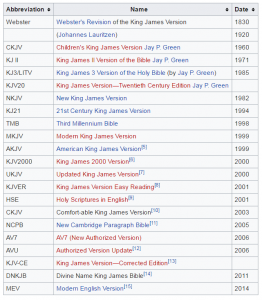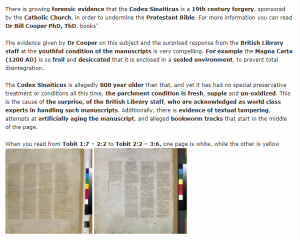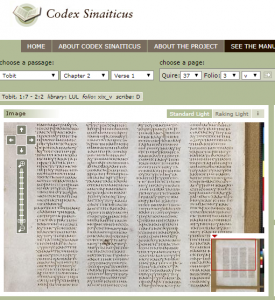There is no point in quoting creationist Bill Cooper again and again, when he has already been refuted by actual textual specialists,.
well thank you for attempting to refute the solid evidence, that is why I like online pictures as they are easily reproduced and collected. I did my own but reversed the order of the pictures so you can tell. Same exact thing, it is because he used pictures from the sinaiticus homepage. So it was the same light with all the pages as my quote below states.
Every page of the manuscript was photographed from various angles, on various backgrounds and with different kinds of light and then the
best photography for digital reading of the text was published online.
Thats why one page can seem to be in a different color than the other one. They choosed best readibility, not the most natural color.
Thats what people working on the sinaiticus digitalization in Brittish Museum said:
Codex Sinaiticus - Digital photography
POST 1 of 2....
Well I guess you missed this very next statement on the website:
"the natural appearance of the parchment and ink had to be faithfully reproduced, to allow the appreciation of the physical traits of Codex Sinaiticus."
Codex Sinaiticus - Digital photography
Also take note on the website, you can see a rainbow color spectrum at the bottom of each page, this is to show that the color is true and to compare the contrast of the page to real color hues. There is no way they would sacrifice color of text for readability when they know that color depicts age.
Further more the website goes on to say:
"Different angles and levels of intensity were tested for the lighting, as the same set-up had to be used for every page."
you can easily see how one page of the manuscript is 25% darker than the other, indicating a different age.
Here is another clip from the book on this:
"
Meanwhile, the forgers at Sinai had made all the mistakes that forgers commonly make. Their alterations were made cosmetically, for appearance’s sake, and so are easy to detect. In this, we are indebted to one Arthur Lucas, author of a most valuable work called
Forensic Chemistry. Lucas, in the early part of the 20th century, was a legal expert in forensic analysis, and his book is dedicated to showing how fraud and forgery can be detected chemically. He does not even touch upon Codex Sinaiticus, but what he has to say on detecting documentary fraud is invaluable to our enquiry. Though he writes here of the effects of true age on paper, it is equally applicable to its effects on parchment (more so, in fact), and it makes interesting reading, very interesting reading indeed:
“Occasionally documents are discoloured intentionally in order to give them a fictitious appearance of age.... Discoloration due to age is largely a process of oxidation brought about by natural means and it takes place in proportion to the extent to which the paper has been exposed to the air and light, and hence the outsides and edges of old documents, which are the most exposed, become the most discoloured, the discoloration progressively diminishing towards the less exposed parts.”3
We noted in the last chapter the pristine condition of the Leipzig leaves, how uniformly white they were even to the outer margins of the page – “white” according to Uspensky, and “snow white” according to Dobschutz and M’Clymont who’d also seen the leaves. And although they are certainly not snow-white, but have been chemically discoloured, the leaves of the British Library segment are nevertheless uniform in their discolouration, just as the Leipzig leaves are uniform and even in their pristine state. In other words, there is little or no sign at all of the strong-to-diminishing oxidisation that would certainly have discoloured the leaves had they been of any real age. It is something that the forger can do nothing about. Pages cannot be oxidised by any rapid or artificial process, but can only become oxidised over long periods of time. After some 1700 years, the pages of Sinaiticus should have discoloured horribly, especially around the edges and outer margins, even to the point of obliterating much of the writing and making the parchment cracked and brittle. Yet the pages of Sinaiticus are all amazingly supple and show little or no sign of oxidisation.
Their freshness, their suppleness, and their unoxidised condition was something that surprised the British Library’s own specialists, as we noted in the previous chapter, though they could offer us no account of how their condition was even possible. But back to Lucas:
“Other natural causes for the discoloration of documents are exposure to dust and dirt and occasionally staining by fruit juice, grease and the excreta of rats, mice and insects. In the latter case the outsides and edges of the documents generally suffer the most. Where a document has been intentionally discoloured with dust, dirt or mud, this is evident as a rule by the discoloration showing definite streaks or lines when carefully examined, the dirt generally having been rubbed on either with a cloth or with the hand.”4
So, natural discolouration has several causes: oxidisation, insect and animal excreta, grease, liquid splashes and spillages (e.g. condensation from generations of readers’ breath, saliva, and even sweat dripping onto the page as they read, as well as moisture and grease from their fingers as they ran them over the page). And then there is the accumulation of dust and dirt which will adhere strongly to the surface of the document if left undisturbed over the centuries. These are all effects that the forger has to duplicate if he is to carry off a convincing appearance of age-old wear and tear. But with parchment as opposed to paper, there are added difficulties.
Parchment is animal skin, and animal skin relies for its strength and suppleness on the presence of the protein collagen. As the collagen within deteriorates over hundreds of years, so the parchment loses its integrity, its suppleness and its strength. It shrinks, curls, cracks and grows brittle, which is again something that lies beyond the power of the forger to emulate. His overriding problem is that none of these processes can be carried out quickly. He would need hundreds of years which he does not have in order to simulate them enough to pass a forensic and microscopic examination. So all he has left are a few ways in which to give a superficial appearance of age, and Lucas tells us how this is commonly achieved:
“Artificial discoloration made to simulate age is produced by means of a coloured solution. The author has never been able definitely to establish the nature of any solution employed, but in the East coffee is very probable, while in the West tea might be used. A water extract of tobacco or a dilute solution of potassium permanganate would also serve the same purpose. The use of a coloured solution is generally indicated by the characteristic shape of the edges of the discoloured areas, or the way in which the liquid has run may be plainly visible, and a thin dark line sometimes occurs where there were any very marked creases on the paper at the time it was treated. Occasionally too portions of the paper, often very small, may be found which have altogether escaped the action of the solution.”
lastly to compare the above with a real fourth century manuscript I will also post an image to this file:
View attachment 270039



